A Velocity Obstacle-Based Real-Time Regional Ship Collision Risk Analysis Method
Abstract
:1. Introduction
2. Methodology
2.1. Overview of the Research
2.2. TCR-Based Collision Risk Modelling
2.3. Spatial Clustering of Maritime Traffic
3. Model Design
3.1. Data Acquisition and Process
3.2. TCR-Based Risk Analysis
3.3. Spatial Clustering for Traffic Characteristic Analysis
3.4. Result Visualisation
4. Case Study
4.1. Data Description and Parameter Setting
4.2. Results and Visualisation
5. Discussion
5.1. Comparison between Risk Measurement and Complexity
5.2. Comparison between TCR-Based Approach and CPA-Based Approach
5.3. Implications and Limitations of the Method
6. Conclusions
Author Contributions
Funding
Institutional Review Board Statement
Informed Consent Statement
Data Availability Statement
Conflicts of Interest
References
- Sirimanne, S.N.; Hoffman, J.; Juan, W.; Asariotis, R.; Assaf, M.; Ayala, G.; Benamara, H.; Chantrel, D.; Hoffmann, J.; Premti, A.; et al. Review of Maritime Transport; United Nations Conference on Trade and Development (UNCTAD): Geneva, Switzerland, 2019. [Google Scholar]
- Mou, J.M.; Chen, P.F.; He, Y.X.; Yip, T.L.; Li, W.H.; Tang, J.; Zhang, H.Z. Vessel traffic safety in busy waterways: A case study of accidents in western shenzhen port. Accid Anal. Prev. 2019, 123, 461–468. [Google Scholar] [CrossRef]
- Lisowski, J. Game control of moving objects. Ifac Proc. Vol. 2002, 35, 373–378. [Google Scholar] [CrossRef] [Green Version]
- Lisowski, J. The analysis of differential game models of safe ship control process. J. Shanghai Marit. Univ. 1985, 1, 25–38. [Google Scholar]
- Chen, P.F.; Huang, Y.M.; Mou, J.M.; van Gelder, P.H.A.J.M. Probabilistic risk analysis for ship-ship collision: State-of-the-art. Saf. Sci. 2019, 117, 108–122. [Google Scholar] [CrossRef]
- Lim, G.J.; Cho, J.; Bora, S.; Biobaku, T.; Parsaei, H. Models and computational algorithms for maritime risk analysis: A review. Ann. Oper. Res. 2018, 271, 765–786. [Google Scholar] [CrossRef]
- Zhen, R.; Riveiro, M.; Jin, Y.X. A novel analytic framework of real-time multi-vessel collision risk assessment for maritime traffic surveillance. Ocean Eng. 2017, 145, 492–501. [Google Scholar] [CrossRef]
- Liu, Z.H.; Wu, Z.L.; Zheng, Z.Y. A novel framework for regional collision risk identification based on AIS data. Appl. Ocean Res. 2019, 89, 261–272. [Google Scholar] [CrossRef]
- Zhang, W.; Feng, X.; Qi, Y.; Shu, F.; Zhang, Y.; Wang, Y. Towards a Model of Regional Vessel Near-miss Collision Risk Assessment for Open Waters based on AIS Data. J. Navig. 2019, 72, 1449–1468. [Google Scholar] [CrossRef]
- Zhang, W.B.; Goerlandt, F.; Kujala, P.; Wang, Y.H. An advanced method for detecting possible near miss ship collisions from AIS data. Ocean Eng. 2016, 124, 141–156. [Google Scholar] [CrossRef]
- Fujii, Y.; Shiobara, R. The Analysis of Traffic Accidents. J. Navig. 1971, 24, 534–543. [Google Scholar] [CrossRef]
- Szlapczynski, R.; Krata, P.; Szlapczynska, J. Ship domain applied to determining distances for collision avoidance manoeuvres in give-way situations. Ocean Eng. 2018, 165, 43–54. [Google Scholar] [CrossRef]
- Szlapczynski, R.; Szlapczynska, J. Review of ship safety domains: Models and applications. Ocean Eng. 2017, 145, 277–289. [Google Scholar] [CrossRef]
- Szlapczynski, R.; Szlapczynska, J. A method of determining and visualizing safe motion parameters of a ship navigating in restricted waters. Ocean Eng. 2017, 129, 363–373. [Google Scholar] [CrossRef]
- Montewka, J.; Hinz, T.; Kujala, P.; Matusiak, J. Probability modelling of vessel collisions. Reliab. Eng. Syst. Saf. 2010, 95, 573–589. [Google Scholar] [CrossRef]
- Zhang, L.; Meng, Q. Probabilistic ship domain with applications to ship collision risk assessment. Ocean Eng. 2019, 186, 106130. [Google Scholar] [CrossRef]
- Gil, M.; Montewka, J.; Krata, P.; Hinz, T.; Hirdaris, S. Determination of the dynamic critical maneuvering area in an encounter between two vessels: Operation with negligible environmental disruption. Ocean Eng. 2020, 213, 107709. [Google Scholar] [CrossRef]
- Montewka, J.; Gil, M.; Wróbel, K. Discussion on the article by Zhang & Meng entitled Probabilistic ship domain with applications to ship collision risk assessment. Ocean Eng. 2019, 186, 106130, Erratum in 2020, 209, 107527. [Google Scholar]
- Chen, P.F.; Huang, Y.M.; Mou, J.M.; van Gelder, P.H.A.J.M. Ship collision candidate detection method: A velocity obstacle approach. Ocean Eng. 2018, 170, 186–198. [Google Scholar] [CrossRef]
- Huang, Y.; van Gelder, P. Time-Varying Risk Measurement for Ship Collision Prevention. Risk Anal. 2020, 40, 24–42. [Google Scholar] [CrossRef]
- He, Y.X.; Jin, Y.; Huang, L.W.; Xiong, Y.; Chen, P.F.; Mou, J.M. Quantitative analysis of COLREG rules and seamanship for autonomous collision avoidance at open sea. Ocean Eng. 2017, 140, 281–291. [Google Scholar] [CrossRef]
- Fiorini, P.; Shiller, Z. Motion planning in dynamic environments using velocity obstacles. Int. J. Robot. Res. 1998, 17, 760–772. [Google Scholar] [CrossRef]
- Huang, Y.M.; van Gelder, P.H.A.J.M.; Wen, Y.Q. Velocity obstacle algorithms for collision prevention at sea. Ocean Eng. 2018, 151, 308–321. [Google Scholar] [CrossRef]
- Ester, M.; Kriegel, H.-P.; Sander, J.; Xu, X. A density-based algorithm for discovering clusters in large spatial databases with noise. In Proceedings of the Second International Conference on Knowledge Discovery and Data Mining, Portland, OR, USA, 2–4 August 1996; pp. 226–231. [Google Scholar]
- Campello, R.J.G.B.; Moulavi, D.; Sander, J. Density-Based Clustering Based on Hierarchical Density Estimates; Springer: Berlin/Heidelberg, Germany, 2013; pp. 160–172. [Google Scholar]
- Ankerst, M.; Breunig, M.M.; Kriegel, H.-P.; Sander, J. OPTICS: Ordering points to identify the clustering structure. Acm Sigmod Rec. 1999, 28, 49–60. [Google Scholar] [CrossRef]
- Zhao, L.; Shi, G. A trajectory clustering method based on Douglas-Peucker compression and density for marine traffic pattern recognition. Ocean Eng. 2019, 172, 456–467. [Google Scholar] [CrossRef]
- International Telecommunications Union. Technical Classifications of Recommendations ITU-M. 1371-4. Technical Characteristics for an Automatic Identification System Using Time-Division Multiple Access in the VHF Maritime Mobile Band; International Telecommunications Union: Geneva, Switzerland, 2010. [Google Scholar]
- Chen, P.; Huang, Y.; Papadimitriou, E.; Mou, J.; van Gelder, P.H.A.J.M. An improved time discretized non-linear velocity obstacle method for multi-ship encounter detection. Ocean Eng. 2020, 196. [Google Scholar] [CrossRef]
- Wang, N. An Intelligent Spatial Collision Risk Based on the Quaternion Ship Domain. J. Navig. 2010, 63, 733–749. [Google Scholar] [CrossRef]
- Openstreetmap. Available online: https://www.openstreetmap.org/ (accessed on 17 August 2020).
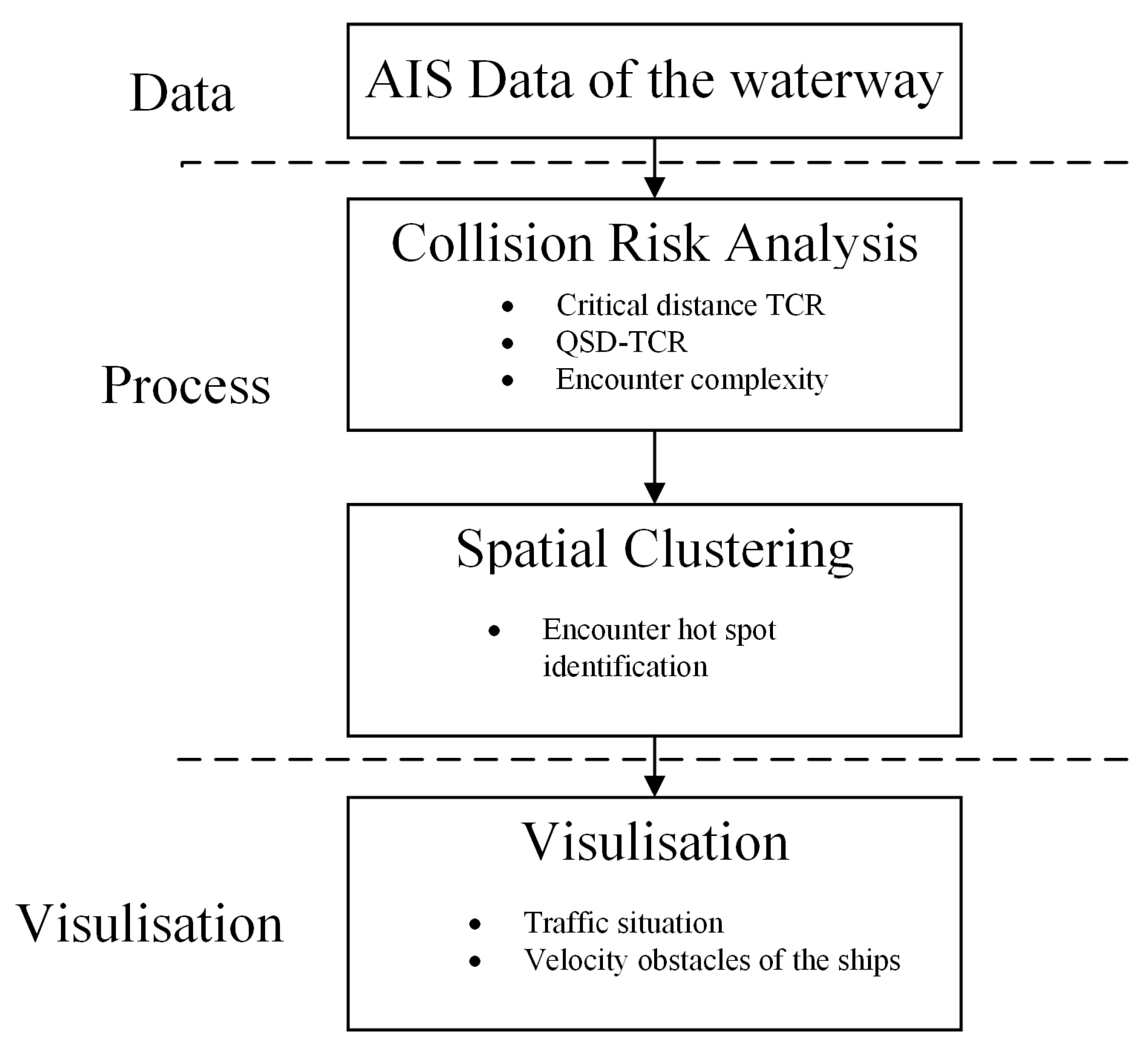
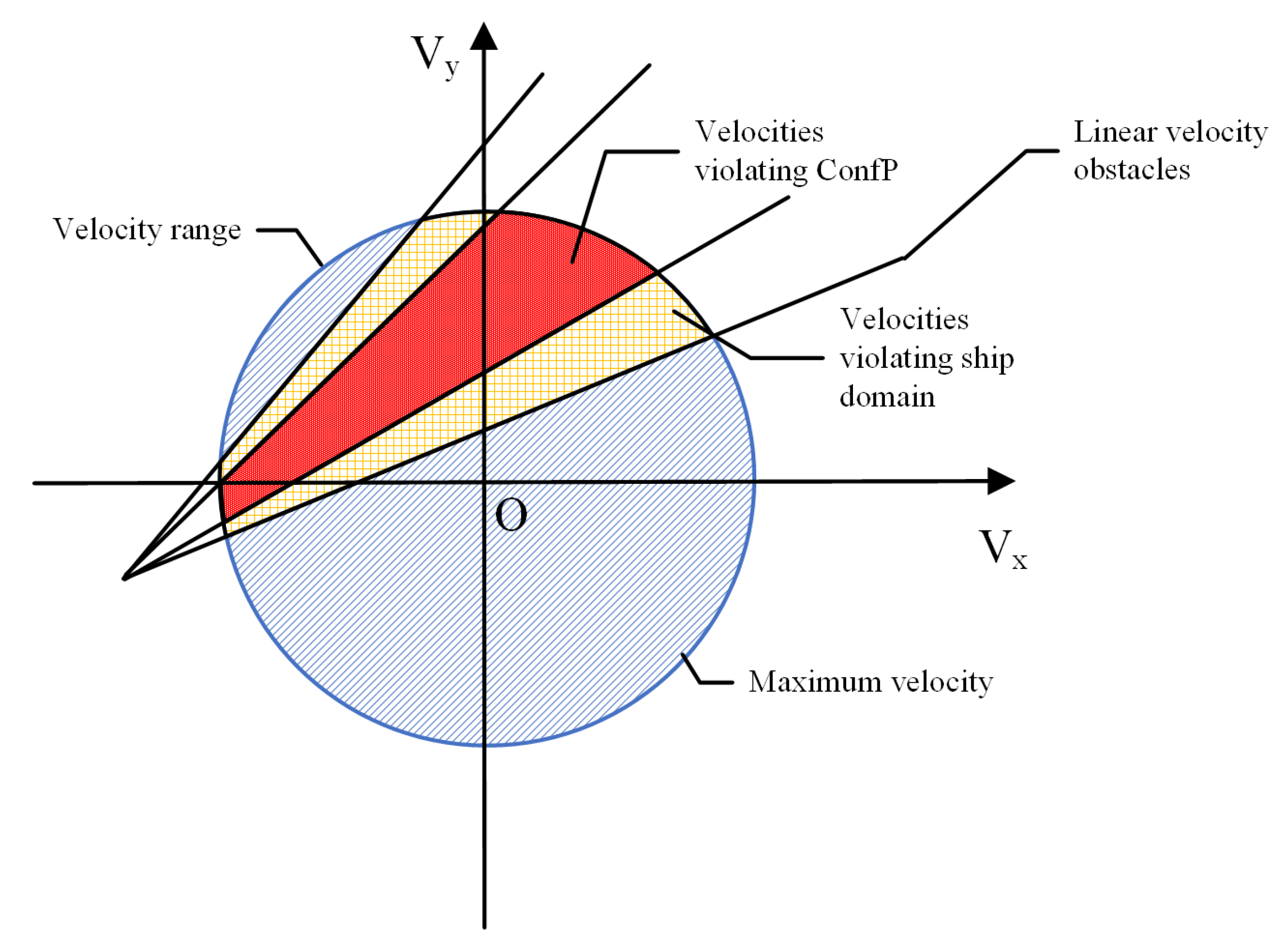
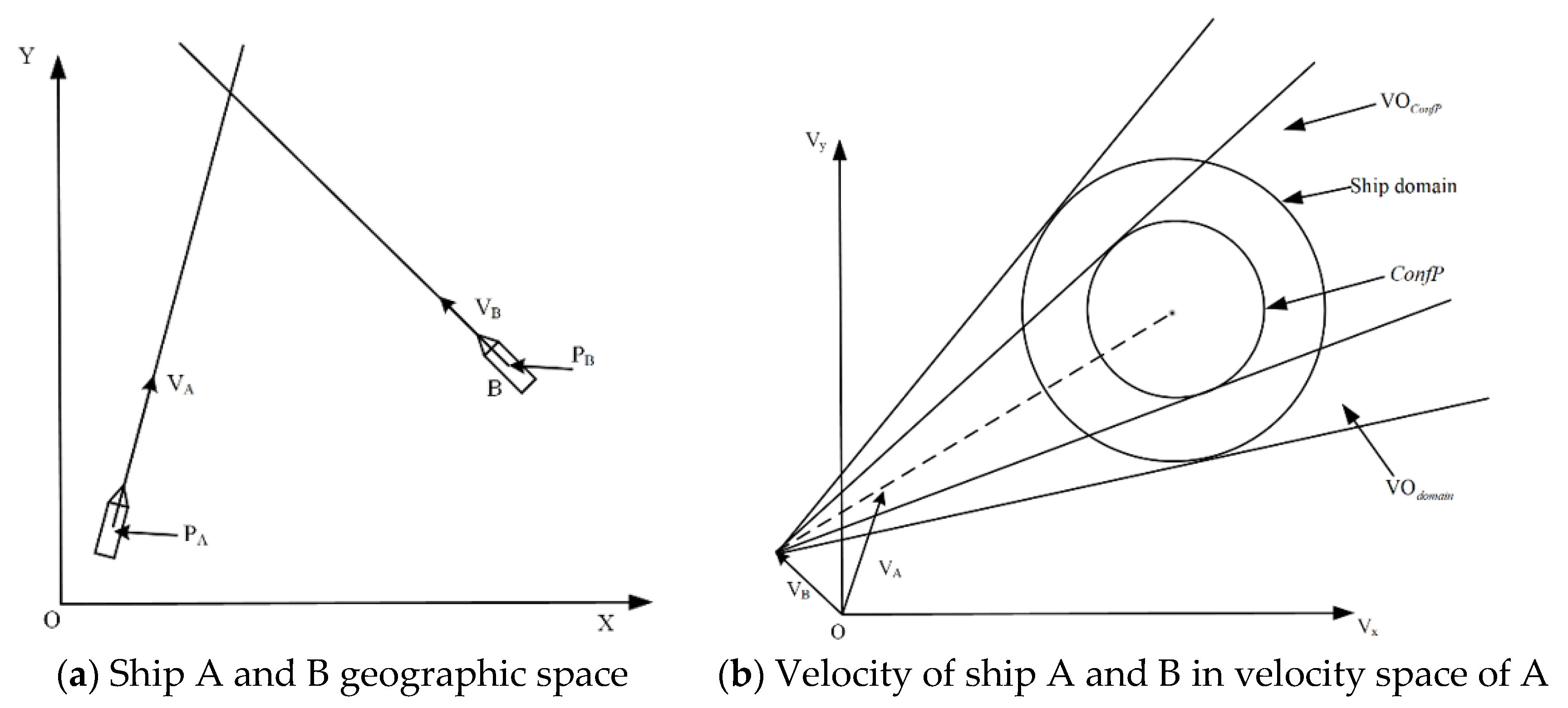
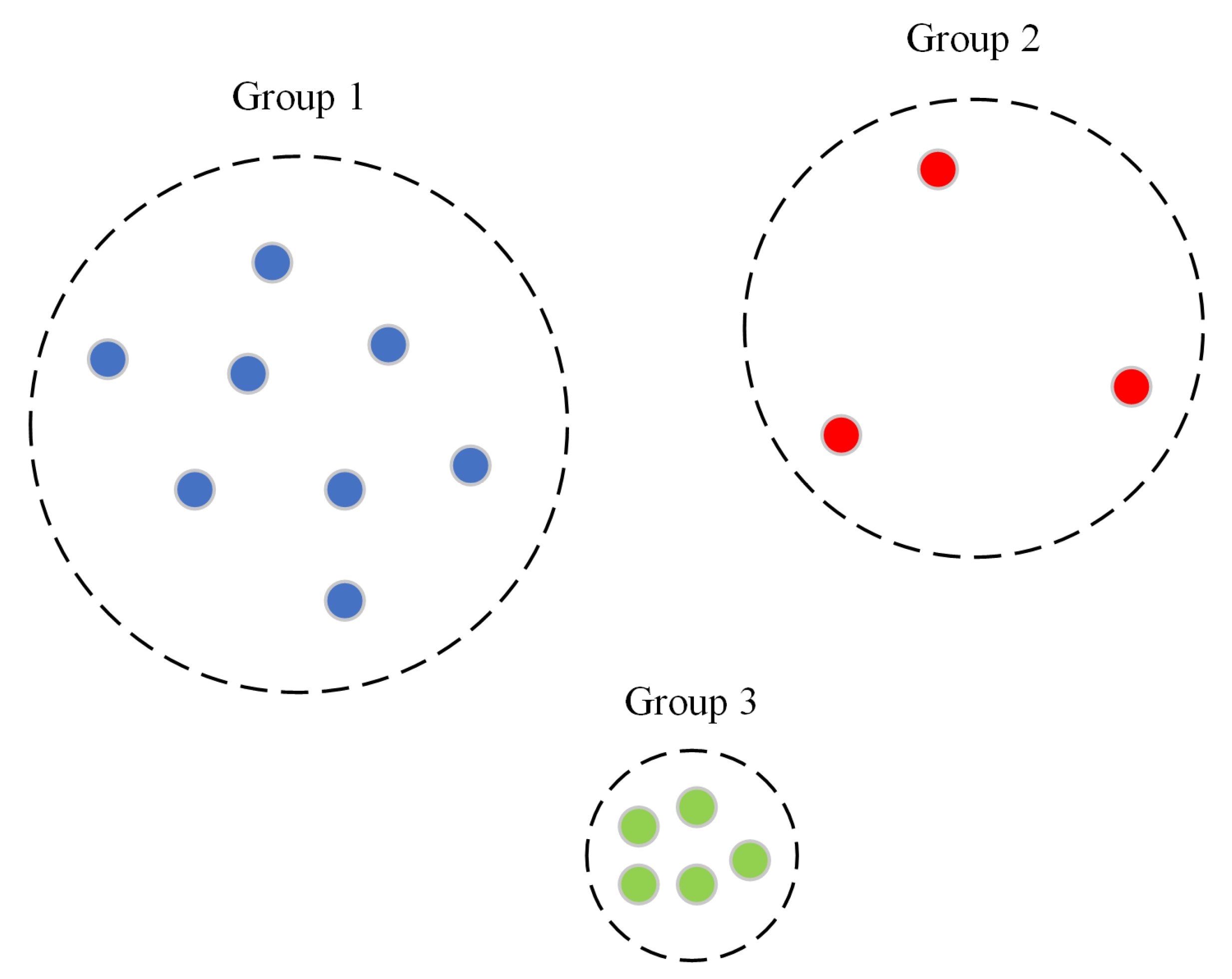
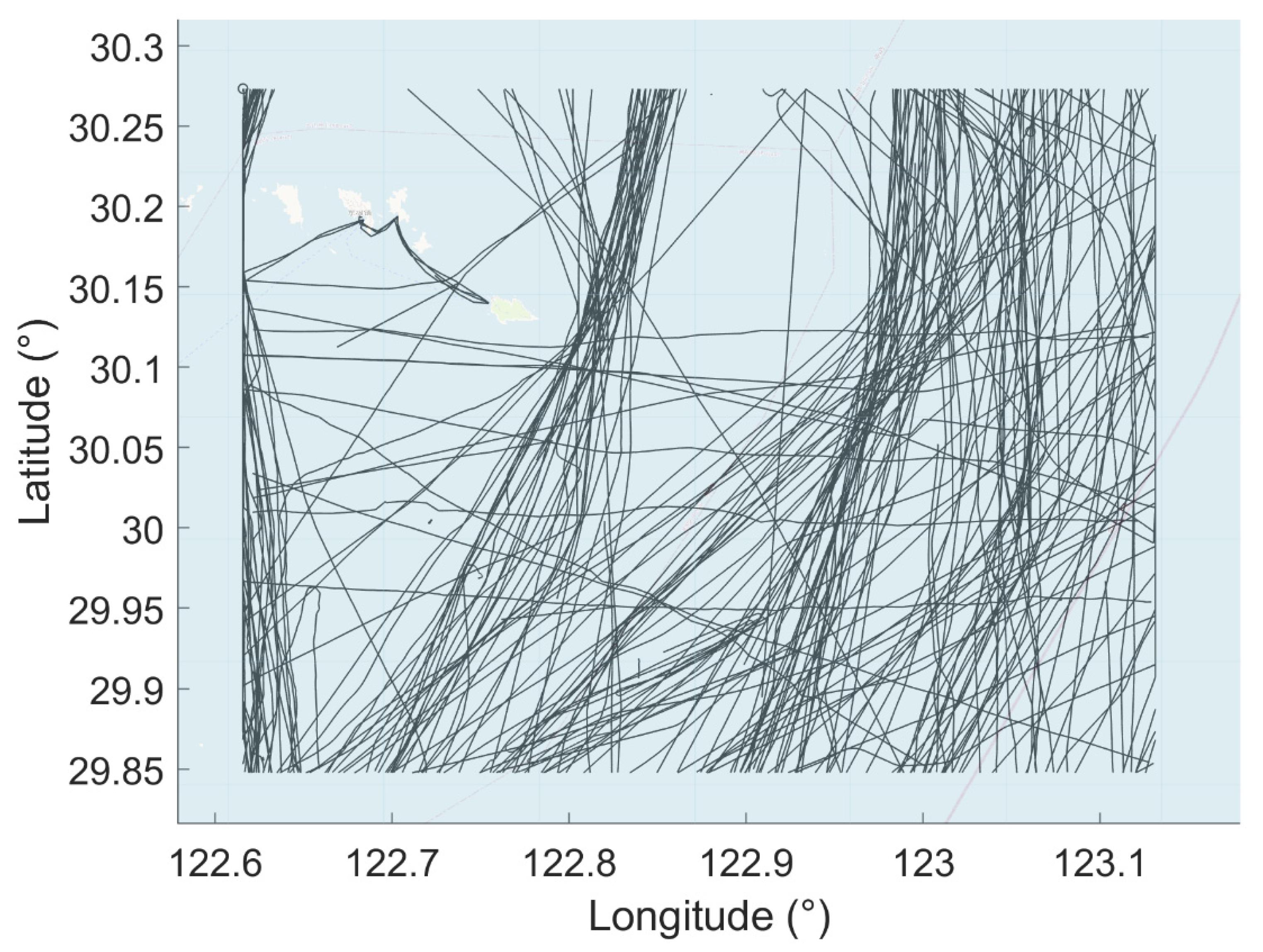
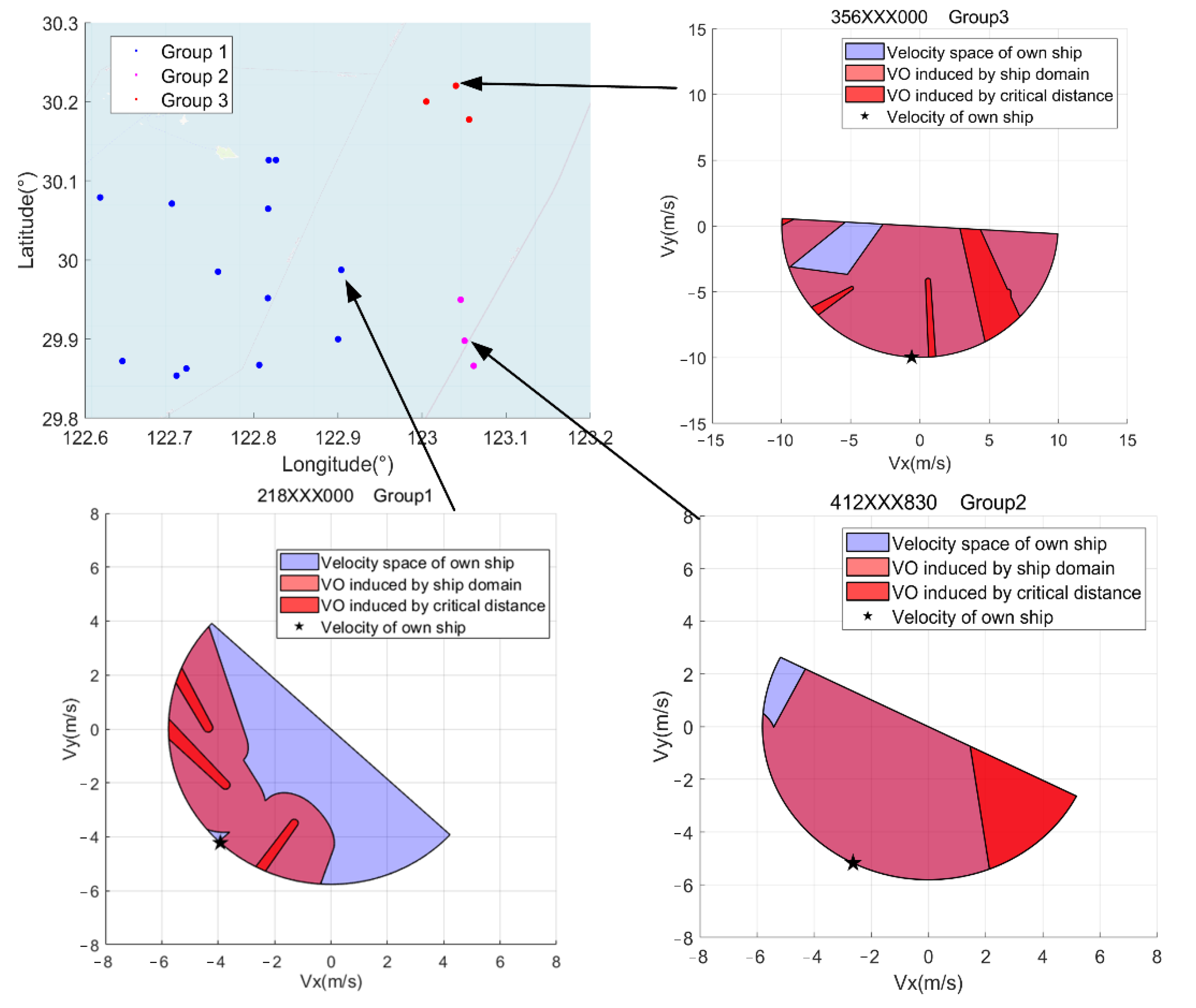
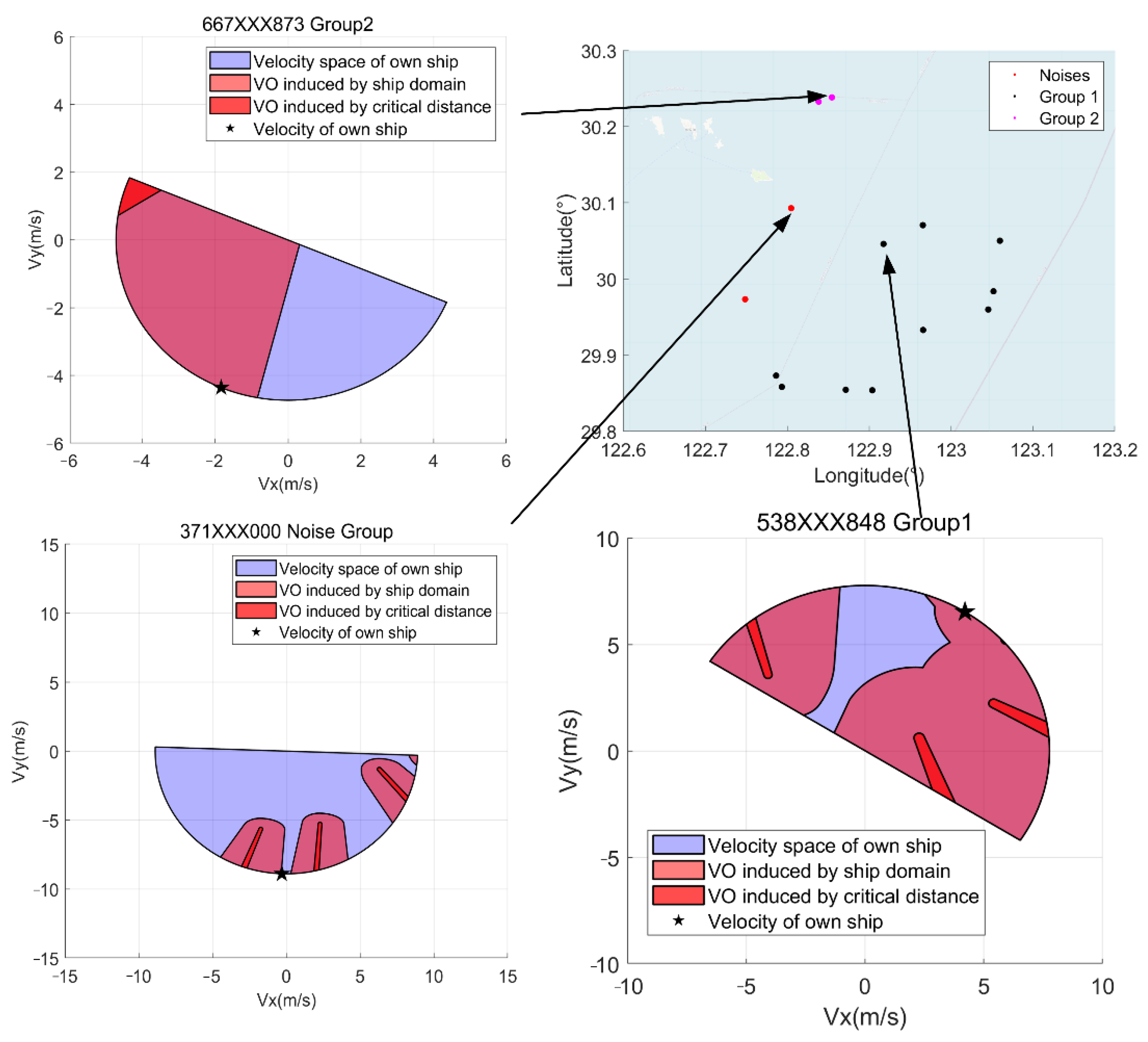
| Variable | Setting |
|---|---|
| Data period | 08:00 7th to 08:00 8th March 2018 (UTC + 8) |
| Data boundary | Latitude: 29.8475-30.2733° N, Longitude: 122.6157-123.1313° E |
| Update frequency | 15 s |
| Eps | 6 nm |
| MinPt | 2 |
| TCR time | 45 min |
| ConfP | Length (own ship + target ship) |
| Ship Length (if no data available) | 200 m |
| Original Time | Interpolation Timespot | MMSI | Critical TCR | Domain TCR | Complexity | Group | Collision Candidate |
|---|---|---|---|---|---|---|---|
| 16:13:59 | 58439 | 218XXX000 | 0.0552 | 0.4670 | 1.1350 | 1 | Yes |
| 16:13:56 | 58439 | 356XXX000 | 0.1420 | 0.9129 | 1.6281 | 3 | Yes |
| 16:13:48 | 58439 | 412XXX830 | 0.1711 | 0.9640 | 1.0014 | 2 | Yes |
| 18:56:41 | 68204 | 371XXX000 | 0.0238 | 0.2836 | 1 | Noise | No |
| 18:56:37 | 68204 | 538XXX848 | 0.0446 | 0.7938 | 1.2922 | 1 | Yes |
| 18:56:37 | 68204 | 667XXX873 | 0.0163 | 0.5926 | 1 | 2 | Yes |
| Original Time | Interpolation Timespot | MMSI (Maritime Mobile Service Identify) | M2 [8] | Complexity | Group (DBSCAN) |
|---|---|---|---|---|---|
| 16:13:59 | 58440 | 218XXX000 | 0.10189 | 1.127 | 1 |
| 16:13:56 | 58440 | 356XXX000 | 0.60342 | 2.289 | 3 |
| 16:13:48 | 58440 | 412XXX830 | 0.32578 | 1 | 2 |
| 18:56:41 | 68204 | 371XXX000 | 0.072746 | 1.244 | Noise |
| 18:56:37 | 68204 | 414XXX000 | 0.19505 | 1.158 | 1 |
| 18:56:37 | 68204 | 667XXX873 | 0.77214 | 1.003 | 2 |
Publisher’s Note: MDPI stays neutral with regard to jurisdictional claims in published maps and institutional affiliations. |
© 2021 by the authors. Licensee MDPI, Basel, Switzerland. This article is an open access article distributed under the terms and conditions of the Creative Commons Attribution (CC BY) license (https://creativecommons.org/licenses/by/4.0/).
Share and Cite
Chen, P.; Li, M.; Mou, J. A Velocity Obstacle-Based Real-Time Regional Ship Collision Risk Analysis Method. J. Mar. Sci. Eng. 2021, 9, 428. https://doi.org/10.3390/jmse9040428
Chen P, Li M, Mou J. A Velocity Obstacle-Based Real-Time Regional Ship Collision Risk Analysis Method. Journal of Marine Science and Engineering. 2021; 9(4):428. https://doi.org/10.3390/jmse9040428
Chicago/Turabian StyleChen, Pengfei, Mengxia Li, and Junmin Mou. 2021. "A Velocity Obstacle-Based Real-Time Regional Ship Collision Risk Analysis Method" Journal of Marine Science and Engineering 9, no. 4: 428. https://doi.org/10.3390/jmse9040428
APA StyleChen, P., Li, M., & Mou, J. (2021). A Velocity Obstacle-Based Real-Time Regional Ship Collision Risk Analysis Method. Journal of Marine Science and Engineering, 9(4), 428. https://doi.org/10.3390/jmse9040428








